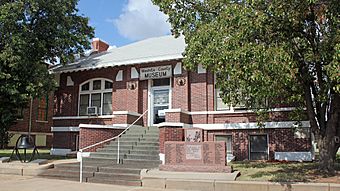Cordell Carnegie Public Library facts for kids
Quick facts for kids |
|
|
Cordell Carnegie Public Library
|
|

Former library, now the Washita County Historical Museum, in 2015.
|
|
| Location | 105 E. First St., Cordell, Oklahoma |
|---|---|
| Area | less than one acre |
| Built | 1911 |
| Built by | Bass, D.C. |
| Architect | Crowell, A.A. |
| Architectural style | Mission Revival, Spanish Colonial Revival |
| NRHP reference No. | 89001966 |
| Added to NRHP | November 13, 1989 |
The Cordell Carnegie Public Library is a historic building in New Cordell, Oklahoma. It was once a special kind of library called a Carnegie library. These libraries were built with money from a rich businessman named Andrew Carnegie. This library was built in 1911. It got a $10,000 grant from the Carnegie foundation.
The building has a unique look. It was designed in the Mission Revival style. It also has parts that look like the Spanish Colonial Revival style. You can see its curved walls and red tile roof. These are common features of the Mission Revival style. The library was the only one in Washita County until the 1960s. It was also a community meeting place. Local schools used it often. In 1982, a new library opened in New Cordell. The old Carnegie Library building then became the Washita County Historical Museum.
How the Library Started
In 1910, a group called the Cordell Commercial Club wanted to start a public library. They formed a committee to collect books. They also wanted to get a grant from the Carnegie Foundation. By April 1910, they had collected 700 books. They got them through donations and purchases. By June, the club found a place to open a reading room.
Later in 1910, the Cordell City Council approved a special tax. This tax money was for the library's running costs. This was a necessary step to apply for a Carnegie grant. The grant for up to $10,000 was approved in January 1911. A company called D. C. Bass Company won the bid to build it. They were paid $7,967. The Carnegie Foundation later gave another $1,000 for more work. The library officially opened on January 18, 1912.
The Cordell Carnegie Library was the only public library in Washita County for many years. A small library was built in Sentinel, Oklahoma in the 1960s. But people and school groups from all over the county still used the Cordell library a lot.
What the Building Looks Like
The building is shaped like a rectangle. It is about 19 feet (5.8 meters) from north to south. It is about 42.5 feet (13 meters) from east to west. The first floor is a bit higher than the ground. It has a basement below. The roof is sloped. It has special curved walls on the east and west sides. These walls are called parapets. They go almost as high as the roof's peak.
The front of the building faces south. It has three main sections. The main entrance is in the middle section. It is set back a bit. It has a curved arch above it. The sections on either side of the entrance also have curved arches. These arches hold three windows each. Above each window is a smaller arched window with stained glass. The original red tile roof was changed in the 1950s. It was replaced with different shingles. A safety handrail was added to the front steps in 1985. These changes did not affect the building's overall historic look.
Inside, the building is mostly the same as when it was built. The main floor is one big room. This used to be the reading room. All the original wood details and trim are still there. In the 1980s, the wood floor was covered with carpet. The original plastered ceiling was covered by a drop ceiling. These changes were made to update the building.
National Historic Listing
The Cordell Carnegie Public Library building is very important. It was added to the National Register of Historic Places on November 13, 1989. This means it is a special historic place. It is also part of the New Cordell Courthouse Square Historic District.
After the new library was built, the old Carnegie Library became the property of the City of Cordell. The city then made a deal with the Cordell Historical Society. They agreed that the society could use the building as a museum. This is how the building became the Washita County Historical Museum.



